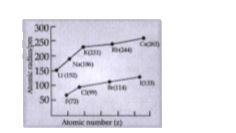Assertion: Metallic character decreases across a period.
Reason: Non metals are electropositive in nature.
If both assertion and reason are true and reason is the correct explanation of assertion.
If both assertion and reason are true, but reason is not the correct explanation of assertion.
If assertion is true, but reason is false.
If assertion is false, but reason is true.
The correct Answer is:C
Non metals are electronegative in nature and metallic character decreases across a period. Thus assertion is true but reason if False.
Similar Questions
Knowledge Check
- Question 1 - Select One
Assertion :- Metallic character increases on going down the group
Reason :- I.E. decreases on going down the groupAIf both Assertion & Reason are True & the Reason is a correct explanation of the Assertion.BIf both Assertion & Reason are True but Reason is not a correct explanation of the Assertion.CIf Assertion is True, but the Reason is False.DIf both Assertion & Reason are false - Question 2 - Select One
Assertion: Metallic character increases from left to right among the elements of 2nd period.
Reason: Second period is called shortest period.ABoth A and B true and R is the correct explanation ABBoth A and R are true but R is not a correct explanation of ACA is true but R is falseDBoth A and R are false - Question 3 - Select One
Assertion: Metallic character of first group metals of Modern periodic table increase on moving down the group.
Reason: On moving top to bottom in first group in Modern periodic table, value of ionisation enthalpy continuously decreases.AIf both assertion and reason are true and reason is the correct explanation of assertionBIf the assertion and reason are true but reason is not the correct explanation of assertion.CIf assertion is true but reason is false.DIf assertion is false but reason is true.
Assertion: Metallic character increases from left to right among the elements of 2nd period.
Reason: Second period is called shortest period.View SolutionRead the following and answer the question
Metallic Character:
The ability of an atom to donate electrons and form positive ion (cation) is known as electro-positivity or metallic character. Down the group, metallic character increases due to increase in atomic size and across the period, from left to right electro-positivity decreases due to decrease in atomic size
Non-Metallic Character:
The ability of an atom to accept electrons to form a negative ion (anion) is called non-metallic character or electronegativity. The elements having high electro-negativity have a higher tendency to gain electrons and form anion.
Down the group, electronegativity decreases due to increase in atomic size and across the period, from left to right electro-negativity increases due to decrease in atomic size.

Which of the following correctly represents the decreasing order of metallic character of Alkali metals plotted in the graph ?View SolutionWhich of the following metal is highest electropositive (metallic) in nature?
View SolutionWhich of the following metal is highest electropositive (metallic) in nature?
View SolutionWhich of the following metal is highest electropositive (metallic) in nature?
View Solution

